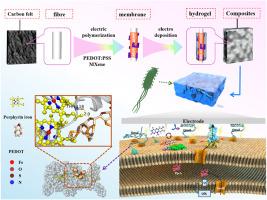“内膜外凝胶”PEDOT:PSS/MXene复合材料通过促进生物膜生长来增强细胞外电子传递过程
IF 10.5
1区 生物学
Q1 BIOPHYSICS
引用次数: 0
摘要
在全球能源需求激增的背景下,微生物燃料电池(mfc)因其在绿色能源转化方面的潜力而备受关注。为了解决微生物在mfc阳极界面远距离电子转移效率低的问题,我们提出了一种新型的“内膜-外凝胶”PEDOT:PSS/MXene双相水凝胶电极。该电极通过电化学聚合制备,进一步使其能够利用柔性的非均质界面促进三维(3D)生物膜的生成。实验结果表明,复合阳极的电荷转移电阻(Rct)低至4.71 Ω,最大功率密度为4.55±0.17 W m-2,是纯水凝胶(仅PEDOT:PSS水凝胶)最大功率密度的1.8倍。此外,16S rRNA测序显示,Geobacter的相对丰度增加到62.22%,表明电生微生物显著富集。分子对接模拟进一步阐明了PEDOT与OmcZ蛋白之间的静电互补和氢键相互作用,为生物膜内导电纳米线与电极之间的高效电子传递提供了理论支持。总体而言,本研究为“内膜-外凝胶”电极提高MFC性能的可行性提供了实验和理论依据,为微生物能量转换装置中高性能导电生物电极的设计提供了新的见解。本文章由计算机程序翻译,如有差异,请以英文原文为准。

‘Inner membrane - outer gel’ PEDOT:PSS/MXene composite material enhances the extracellular electron transfer process by promoting biofilm growth
Against the backdrop of surging global energy demand, microbial fuel cells (MFCs) have garnered significant attention for their potential in green energy conversion. To solve the problem of low efficiency of long-distance electron transfer by microorganisms at the anode interface of MFCs, we propose a novel ‘inner membrane - outer gel’ PEDOT:PSS/MXene dual-phase hydrogel electrode. The electrode is fabricated via electrochemical polymerization, which further enables it to use a flexible heterogeneous interface to promote three-dimensional (3D) biofilm generation. Experimental results indicate that the composite anode exhibits a charge transfer resistance (Rct) as low as 4.71 Ω, with a maximum power density of 4.55 ± 0.17 W m-2, which is 1.8 times the maximum power density of a pure hydrogel (only PEDOT:PSS hydrogel). Furthermore, 16S rRNA sequencing revealed that the relative abundance of Geobacter increased to 62.22 %, indicating a significant enrichment of electrogenic microorganisms. Molecular docking simulations further elucidated the electrostatic complementarity and hydrogen bonding interactions between PEDOT and the OmcZ protein, providing theoretical support for efficient electron transfer between conductive nanowires and electrodes within biofilms. Overall, this study provides both experimental and theoretical evidence for the feasibility of the ‘inner membrane - outer gel’ electrode in enhancing MFC performance, offering new insights into the design of high-performance conductive bioelectrodes in microbial energy conversion devices.
求助全文
通过发布文献求助,成功后即可免费获取论文全文。
去求助
来源期刊

Biosensors and Bioelectronics
工程技术-电化学
CiteScore
20.80
自引率
7.10%
发文量
1006
审稿时长
29 days
期刊介绍:
Biosensors & Bioelectronics, along with its open access companion journal Biosensors & Bioelectronics: X, is the leading international publication in the field of biosensors and bioelectronics. It covers research, design, development, and application of biosensors, which are analytical devices incorporating biological materials with physicochemical transducers. These devices, including sensors, DNA chips, electronic noses, and lab-on-a-chip, produce digital signals proportional to specific analytes. Examples include immunosensors and enzyme-based biosensors, applied in various fields such as medicine, environmental monitoring, and food industry. The journal also focuses on molecular and supramolecular structures for enhancing device performance.
 求助内容:
求助内容: 应助结果提醒方式:
应助结果提醒方式:


